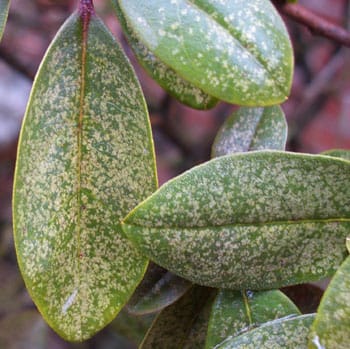Source(s): Stephen D Pettis
The azalea lacebug is a pest that gardeners in the South face nearly every year. As azaleas begin to bloom, the insect begins its lifecycle. By the end of the summer, gardeners find their azalea leaves covered with yellow speckles and the plants are stressed. This leads to reduced vigor and flowering the subsequent year is diminished.
This nuisance pest infests most Rhododendron species although less serious infestations may go unnoticed. Damage appears as stippling or yellow spotting caused by the insect’s feeding on leaves with its sucking mouthparts. Feeding mars the appearance of foliage on both deciduous and evergreen azaleas. The feeding occurs on the underside of the leaves and is apparent on the upper leaf surface in the form of bleached, chlorotic spots that persist through leaf drop. Severe infestations can cause leaves to turn brown and impact overall plant health and vigor.
The adults are between 3 mm long and 1.5 mm wide and dark in color. The insects have a hood-like covering on the head and net-like, lacy, off-white wings with mottled brownish-black markings that may be seen with a hand lens. The insect resembles a fly that has lacy wings thus the name lacebug. Eggs may be visible with the use of a hand lens and appear as smooth, white football shaped objects that are deposited on the underside of leaves. These deposits are usually found along the central leaf vein and are covered with blackish, varnish-like fecal spots that are a diagnostic sign.
Nymphs, the tiny immature insects that follow the eggs in the lacebug lifecycle, are colorless when newly hatched, but quickly become dark and develop spines. The insect passes through five nymphal stages and sheds its skin each time. The cast skins often remain attached to the underside of leaves.
Azalea lacebugs over-winter primarily as eggs on the underside of leaves thus favoring evergreen azaleas. Eggs mature in response to temperature and in Georgia typically begin to hatch in March to early April. There are usually 3 to 4 generations per year and during the growing season the insect progresses from egg to adult in about 30 days.
Controlling this insect is simple. Growers should begin scouting for the eggs and cast skins in Mid March. Usually, a single well-timed spray is sufficient to prevent serious aesthetic injury. Applications should be timed to coincide with the first signs of the nymphal hatch stage that normally occurs in March to mid April. Chemical controls include acephate Orthene (acephate), Bayer Advanced Insect Spray (imidacloprid), oils, and soaps. Remember to read the label carefully and follow all instructions when using pesticides. If you have any questions about azalea culture or about azalea lacebug control, please contact your local County Extension Agent.
Resource(s): Insect Pests of Ornamental Plants
Center Publication Number: 65
- Herbicide Damaged Plants - September 24, 2013
- IPM in the Garden - September 24, 2013
- Leylands Get Really Big - September 24, 2013
